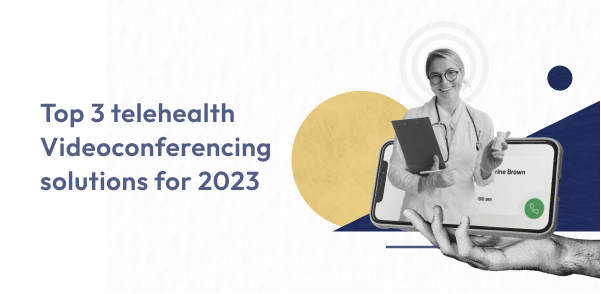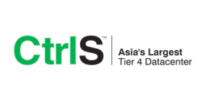Telehealth videoconferencing solutions have become increasingly popular in recent years as a way to provide remote healthcare services. As technology continues to advance, the options for healthcare app solutions are becoming more varied and sophisticated.
In this blog, we will take a look at the top 3 telehealth videoconferencing solutions for 2023 that are currently available on the market. Whether you’re a healthcare provider looking to implement telehealth videoconferencing solutions or custom telehealth app solutions, then this is a proper guide for you.
What is Telehealth video conferencing, and how does it work? Telehealth video conferencing is a revolutionary solution that enables healthcare professionals to provide remote healthcare services to patients through video conferencing technology. With these solutions, patients can have virtual consultations with their healthcare provider, receive treatment plans, and even have virtual follow-up appointments from the comfort of their own homes. This technology is particularly useful for patients with mobility issues or lives in remote areas where access to healthcare can be limited.
They typically use a web-based platform that allows patients to connect with their healthcare provider through a secure video conferencing link. To use telehealth video conferencing, patients usually need a computer, tablet, or smartphone with a camera, microphone, and internet connection. Once connected, patients can see and hear their healthcare provider in real-time and even share images, documents, and other information as needed.
Telehealth video conferencing is becoming increasingly popular as technology continues to improve. It became easier for the patients to receive the care they needed without having to travel long distances or wait for appointments.
Upgrade your healthcare experience with our telehealth app development services.
Top 3 Telehealth video conferencing solutions in 2023
Telehealth video conferencing solutions have become an essential tool for healthcare providers looking to offer remote healthcare services to patients. With the rise in technology advancements, there are now a wide variety of telehealth video conferencing solutions available on the market. In this comprehensive guide, we will take a look at the top 3 telehealth video conferencing solutions for 2023 that are currently available.
Zoom for Healthcare: Zoom is a popular telehealth video conferencing solution that offers a range of features, including high-definition video and audio, screen sharing, and the ability to schedule and manage virtual appointments. It is also fully HIPAA compliant, making it a secure option for healthcare providers. Zoom also offers the ability to integrate with electronic health records, allowing for the seamless and secure sharing of patient information.
VSee: Vsee is a telehealth video conferencing software solution that allows for secure and efficient communication between healthcare providers and patients. It is designed to support remote consultations, follow-up appointments, and team collaboration. VSee features include video, audio, chat, and screen sharing, as well as tools for virtual examinations and remote monitoring. It is often used in telemedicine, telehealth, and telepsychiatry settings.
Doxy.me: Doxy.me is a user-friendly telehealth video conferencing solution that offers a range of features, including virtual waiting rooms, appointment scheduling, and the ability to share documents and images. It is also fully compliant with HIPAA regulations, making it a secure option for healthcare providers. Doxy.me also offers a free plan for solo practitioners, making it a cost-effective option for small practices.
There are other telehealth video conferencing solutions, such as Telehealth by SimplePractice. This platform is designed specifically for mental health professionals and offers a range of features, including secure video conferencing, appointment scheduling, and the ability to share documents and images. It also integrates with electronic health records and complies with HIPAA regulations. SimplePractice also offers a variety of pricing options, making it a flexible option for practices of all sizes.
Comparing the top 3 Telehealth video conferencing solutions of 2023
The best telehealth solutions enable remote clinical care, allowing doctor and patient interaction. And here is a comparison of the top 3 telehealth video conferencing solutions.
Zoom for Healthcare offers high-definition video and audio, screen sharing, and the ability to schedule and manage virtual appointments. It is also fully HIPAA compliant and offers integration with electronic health records.
VSee is also a telemedicine and video conferencing platform that is designed for healthcare providers. It offers features such as video, audio, chat, and screen sharing, and tools for virtual examinations and remote monitoring. VSee is also HIPAA compliant and offers end-to-end encryption for secure communication.
Doxy.me is a user-friendly telehealth video conferencing solution that offers a range of features, including virtual waiting rooms, appointment scheduling, and the ability to share documents and images. It is also fully compliant with HIPAA regulations and offers a free plan for solo practitioners.
When comparing these three solutions, it’s important to consider your specific needs and the features that are most important to you. Zoom for Healthcare offers advanced features like EHR integration, while VSee have virtual examination and remote monitoring tools. Doxy.me is a cost-effective option for small practices. Ultimately, it’s essential to evaluate the features and pricing of each solution to determine which one will best meet your needs.
Conclusion
In conclusion, telehealth videoconferencing solutions are becoming increasingly popular as a way to provide remote healthcare services. If you’re considering implementing or custom developing a telehealth videoconferencing solution for your organization contact us to help you in choosing the best solution for your organization and guide you through the implementation process.
Let’s transform your business for a change that matters.
F. A. Q.
Do you have additional questions?
Telehealth video conferencing is a technology that allows healthcare providers to conduct virtual consultations with patients over the internet using video and audio communication tools. This can be done through various devices such as smartphones, tablets, or computers. Patients can connect with their healthcare provider from the comfort of their own homes or wherever it may be convenient for them. The healthcare provider can use video conferences to diagnose and treat patients, review test results, and even prescribe medications, all remotely. Telehealth video conferencing uses a secure internet connection and specialized software that allows for real-time video and audio communication between the patient and healthcare provider. The software also includes tools for sharing information and documents, such as medical records, test results, and images.
- Convenience: Telehealth video conferencing allows patients to have virtual appointments with their healthcare providers from the comfort of their own homes or office.
- Accessibility: Telehealth video conferencing can provide access to healthcare services for patients who live in remote or underserved areas or for those who have mobility issues.
- Time-saving: Telehealth video conferencing eliminates the need for patients to travel to a physical office, which can save them time and money.
- Cost-effective: Telehealth video conferencing can reduce healthcare costs by reducing the need for in-person appointments and reducing the need for travel.
- Improved communication: Telehealth video conferencing allows for real-time communication between patients and healthcare providers, leading to better diagnosis and treatment.
- Increased patient engagement: Telehealth video conferencing allows patients to actively participate in their own healthcare by being able to ask questions and receive information in real-time.
- Flexibility: Telehealth video conferencing can be scheduled at a convenient time for both the patient and the healthcare provider, which can lead to increased patient satisfaction.
- Zoom for Healthcare: Zoom is a popular telehealth video conferencing solution that offers a wide range of features specifically designed for healthcare providers. It offers end-to-end encryption, HIPAA compliance, and integration with electronic health records (EHRs).
- Doxy.me: Doxy.me is a telehealth video conferencing platform that is easy to use and offers a variety of features, such as appointment scheduling, patient intake forms, and integration with EHRs.
- VSee: VSee is a telehealth video conferencing platform that offers features such as remote monitoring, secure messaging, and integration with EHRs.
- Updox: Updox is a telehealth video conferencing solution that offers features such as appointment scheduling, patient intake forms, and integration with EHRs.
Telehealth video conferencing must comply with the Health Insurance Portability and Accountability Act (HIPAA) regulations to ensure the privacy and security of patient health information.
- Encryption: Telehealth video conferencing solutions must use encryption to protect patient health information during transmission. This means that the data sent between the healthcare provider and patient is encrypted and can only be accessed by authorized parties.
- Access controls: Telehealth video conferencing solutions must have access controls in place to ensure that only authorized individuals can access patient health information. This includes login credentials, password protection, and other forms of authentication.
- Audit trails: Telehealth video conferencing solutions must have audit trails in place to track who has accessed patient health information and when. This allows healthcare providers to monitor and detect unauthorized access to patient health information.
- Data backup: Telehealth video conferencing solutions must have data backup and disaster recovery procedures in place to ensure that patient health information is not lost during a system failure or other disaster.
- Compliance reporting: Telehealth video conferencing solutions must provide compliance reporting to ensure they meet all HIPAA regulations.
- Technical Safeguards: Telehealth video conferencing solutions must have technical safeguards to protect patient health information, such as firewalls, intrusion detection, and malware protection.
- Ensure that your patients are properly prepared for their telehealth video conferencing appointment by providing them with instructions on how to use the platform, as well as what to expect during the appointment.
- Make sure your patients have a reliable internet connection and a device with a camera and microphone before the appointment.
- Use screen-sharing and other interactive tools to help patients understand their condition and treatment options.
- Encourage patients to ask questions and participate actively in their own care.
- Make sure to use a secure and compliant telehealth video conferencing platform that meets HIPAA regulations.
- Continuously evaluate patients’ experience and improve the platform and the process to increase the effectiveness of telehealth video conferencing for your patients.
- Be available for your patients in case of technical issues or other concerns during the appointment and make sure to have a plan B in case of any technical difficulties.














